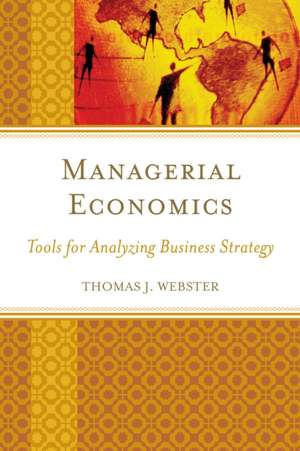Managerial Economics
Autor Thomas J. Websteren Limba Engleză Paperback – 23 mar 2017
Preț: 542.23 lei
Nou
Puncte Express: 813
Preț estimativ în valută:
103.76€ • 108.60$ • 86.36£
103.76€ • 108.60$ • 86.36£
Carte tipărită la comandă
Livrare economică 31 martie-14 aprilie
Preluare comenzi: 021 569.72.76
Specificații
ISBN-13: 9781498507950
ISBN-10: 1498507956
Pagini: 442
Dimensiuni: 231 x 157 x 35 mm
Greutate: 0.66 kg
Editura: Rowman & Littlefield
ISBN-10: 1498507956
Pagini: 442
Dimensiuni: 231 x 157 x 35 mm
Greutate: 0.66 kg
Editura: Rowman & Littlefield
Cuprins
Contents
Chapter 1 Managerial Economics and Strategy
The role of economics in business management
What is economics?
What is managerial economics?
Strategic behavior
Quantitative methods
The role of a manager
The role of profit
The objective of the firm
What¿s a company worth?
Types of profit
Constraints on the operations of the firm
Conflicts of interest
Other players
Thinking at the margin
Deriving marginal from total values
Chapter exercises
Chapter 2 Demand and Supply
Demand
Income and substitution effects
Demand determinants
Estimating the market demand equation
Consumer surplus
Supply
Supply determinants
Producer surplus
Market Equilibrium
Net Social Welfare
Changes in Demand and Supply: Price and Output Determination
Demand shifts
Demand and supply shifts
Rationing Function of Prices
Price ceilings
Price floors
Allocating Function of Prices
Chapter exercises
Chapter 3 Elasticity
Price Elasticity of Demand
Calculating the price elasticity of demand
Definitions
Determinants of the price elasticity of demand
Total and marginal revenue
Formal relationship between the price elasticity of demand and total revenue
Income Elasticity of Demand
Cross-Price Elasticity of Demand
Advertising Elasticity of Demand
Chapter exercises
Chapter 4 Production and Cost
The Production Function
Production relationships
Productivity Measures
Average and marginal products of a variable input
Law of Diminishing Returns
Isoquants
Cost in the Short Run
Total cost
Average and marginal costs
Functional form of the total cost equation
Isocost Line
Learning Curve Effect
Cost in the Long Run
Economies and diseconomies of scale
Sources of economies of scale
Sources of diseconomies of scale
Multiproduct Cost Functions
Economies of scope
Cost complementarities
Chapter Exercises
Chapter 5 Profit Maximization
Profit Maximization
Optimal input combinations
Maximizing profit in practice
Optimal input substitution
How to Procure Inputs
Spot exchange
Contracts
Vertical integration
Specialized Investments
Types of specialized investment
Bargaining costs
Underinvestment
Opportunism
Procuring Inputs Involving Specialized Investments
Promoting Maximum Effort: The Principal-Agent Problem
Owner-manager principal-agent problem
Manager-worker principal-agent problem
Chapter Exercises
Chapter 6 Corporate Structure and Culture
The Supply Chain
Transaction costs
Vertical Integration
Horizontal Integration
Economies of scale
Economies of scope
Diversification
Economies of scale and scope
Lower transactions costs
Smoother cash flows
Internal financing
Diversifying shareholder investment
Undervalued firms
Strategic Alliances
Firm Architecture
Evolution of the modern corporation
Organizational Structure
Types of Organizational Structure
Unitary (functional) form (u-form)
Multidivisional form (m-form)
U-form/M-form hybrid
Matrix structure
Contractual network
Strategy or Structure: Chicken or Egg?
Corporate Culture
Unwritten rules
Creating a corporate culture
Chapter Exercises
Chapter 7 Industry Organization
Market Structure
Number, size, and distribution of rival firms
Number, size, and distribution of buyers
Product differentiation
Entry and exit conditions
The Five Forces
Threat of entry
Threat of substitutes
Competitive rivalry
Bargaining power of buyers
Bargaining power of suppliers
Industry Types
Perfect competition
Imperfect competition
Monopoly
Industrial Concentration
Concentration ratios
Herfindahl-Hirschman index
Market Power and Pricing
Lerner index
Rothschild index
Profitability
Variations in profits across firms and industries
Other Criteria for Classifying Industries
Production technology
Nature of market demand
Degree of industrial integration
Research and development
Chapter Exercises
Chapter 8 Perfect Competition and Monopoly
Perfect Competition
Short-run perfectly competitive equilibrium
Economic losses and shutdown
Long-run perfectly competitive equilibrium
Monopoly
Sources of monopoly power
Barriers to entry
Welfare implications of monopoly
Landmark U.S. Antitrust Legislation
Sherman Act (1890)
Clayton Act (1914)
Federal Trade Commission Act (1914)
Willis-Graham Act (1921)
Robinson-Patman Act (1936)
Wheeler-Lea Act (1938)
Celler-Kefauver Act (1950)
Hart-Scott-Rodino Act (1980)
Contestable Markets
Chapter Exercises
Chapter 9 Imperfect Competition
Oligopoly
Oligopoly Models
Cournot model
Stackelberg model
Bertrand model
Bertrand paradox
Collusion
Comparing oligopoly models
Monopolistic Competition
Short-run profit-maximizing price and output
Long-run profit-maximizing price and output
Advertising and product differentiation
Product Differentiation and Strategic Behavior
Chapter Exercises
Chapter 10 Thinking Strategically
What is Game Theory?
Lexicon of game theory
Rational versus actual behavior
Static Games
Nash equilibrium
Secure strategy
Mixed Strategies
Cooperation
Finitely-repeated static games
Tit-for-tat
Infinitely-repeated static games
Evaluating payoffs in infinitely-repeated games
Dynamic Games
Subgame perfection
Backward induction
First-mover advantage
Chapter Exercises
Chapter 11 Pricing Strategies
Standard Pricing Rule
Extracting consumer surplus
First-degree price discrimination
Second-degree price discrimination
Third-degree price discrimination
Special Pricing Practices
Capacity peak-load pricing
Multiproduct pricing
Non-Marginal Pricing
Cost-plus pricing
Price fixing
Price matching
Most-favored customer
Price leadership
Penetration pricing
Transfer Pricing
No external market
Perfectly competitive external market
Entry Deterrence
Limit pricing
Chapter Exercises
Chapter 12 Bargaining
The Bargaining Problem
Nash Bargaining
Rubenstein Bargaining
Last-mover advantage
Symmetric impatience
Asymmetric impatience
Chapter Exercises
Chapter 13 Economics of Information
Risk and Uncertainty
Mean
Variance
Standard deviation
Static Games with Uncertain Payoffs
Attitudes toward Risk
Risk aversion
Understanding risk-averse behavior
Managing Risk
Diversification
Options contracts
Uncertainty and Search Costs
Dynamic Games with Uncertain Payoffs
Bayesian updating
Asymmetric Information
Adverse selection
Moral hazard
Separating and pooling strategies
Screening
Chapter Exercises
Chapter 14 Contracts
Contracting Environment
Contracting Phase
Implementation Phase
Self-enforcement
External enforcement
Breach Remedies
Expectation damages
Reliance damages
Restitution damages
Chapter Exercises
Chapter 15 Auctions
Auctions and the Internet
Types of Auctions
Information Structures
Incomplete-Information Auctions with Independent Private Values
Sealed-bid, first-price auction
Sealed-bid, second-price auction
English auction
Dutch auction
Expected revenues from incomplete-information auctions with independent private values
Incomplete-Information Auctions with Correlated Value Estimates
Common-value auctions and the winner¿s curse
Incomplete-Information Auctions and Risk Aversion
Chapter Exercises
Chapter 16 Networks
Evolutionary Game Theory
Reproductive success
Evolutionary equilibrium
Networks
Positive feedback effects
Network game
Implications
Restraint of Trade in Network Industries
Bottlenecks
Technical standards
B2B exchanges
Chapter Exercises
AppendixRegression Analysis
Estimation
Diagnostics
Confidence intervals
t-statistic
p-value
Coefficient of determination
Adjusted coefficient of determination
Respecifying the regression equation
Glossary
References
Notă biografică
By Thomas J. Webster
Descriere
This textbook develops tools for identifying optimal solutions to business problems by combining the various business disciplines with quantitative methods to efficiently achieve a firm's organizational objectives.











